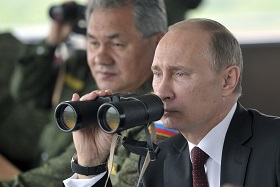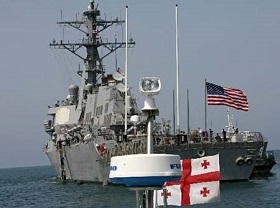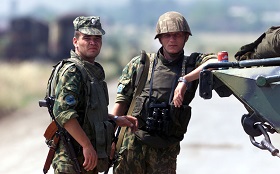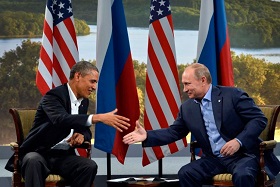Why a War With the US Is Unlikely
(no votes) |
(0 votes) |
PhD in Political Science
The RIAC recently published an article on its website entitled “Is a War against America Possible?” which attracted considerable attention and sparked lively debate. In its key claim, the paper asserted that serious differences are developing between the US and Russia, which in the near future, may lead to direct armed confrontation between Moscow and Washington. It would be extremely naïve to argue that a direct armed conflict between Russia and the U.S. is impossible, but this development is no more likely now than during the Cold War.
The RIAC recently published an article on its website entitled “Is a War against America Possible?” which attracted considerable attention and sparked lively debate. In its key claim, the paper asserted that serious differences are developing between the US and Russia, which in the near future, may lead to direct armed confrontation between Moscow and Washington.
This rather stimulating article raised a whole series of issues related to Russia-U.S. relations that have largely been glossed over lately. However, the main idea of the article is very open to dispute. It would be extremely naïve to argue that a direct armed conflict between Russia and the U.S. is impossible, but this development is no more likely now than during the Cold War.
Extrapolating from History
There have been several times throughout relations between the U.S. and the USSR (later replaced by Russia) when the likelihood of armed conflict was quite high. The most textbook cases include the 1962 Cuban Missile crisis; the First and particularly the Second Berlin crises in 1948-1949 and in 1961 respectively; the crisis over “European missiles” in 1983; and the U.S.-led operation in Yugoslavia in 1999.
In the event of a “controlled” escalation when the threat of a conflict might grow into a nuclear war, there exists a high possibility for a limited armed confrontation between the U.S. and Russia.
Entire periods in Russia-U.S. relations have been marked by mutual confrontation and teetering on the edge of war. The most ominous were the 1950s and the early 1980s. The Eisenhower Administration's opportunistic doctrine of “massive retaliation,” announced in 1954 by John Dulles, Secretary of State, and the associated NATO concept of a vertical escalation of conflict both presupposed the launch of a total nuclear war in response to any attempt by the USSR to inflict any harm on the U.S. or NATO countries. This low conflict threshold and the threat of a preventive strike by the US were supposed to restrain Soviet “expansion”. At the same time, the USSR was not prepared to yield to an American blackmail of force. However, this situation never resulted in actual conflict.
In the early 1980s Ronald Reagan, once an actor and a TV host, was elected U.S. President. President Reagan was arguably one of the most outstanding U.S. presidents, having contributed considerably to the American “victory” in the Cold War. However, his methods and the proclaimed doctrine of “offensive globalism” were no less opportunistic or risk-taking than the policies under President Eisenhower. Both acted with maximum ruthlessness and directness, imposing an international standoff with the USSR. The American leaders and the ageing Soviet leadership were not restrained either in means or methods, often walking a very fine line indeed. Ronald Reagan could afford to joke about the USA “beginning bombing efforts in five minutes”, while the Soviet SU-15 fighter did not hesitate to shoot down a South Korean passenger airplane. However, this long period of faceoff did not result in armed conflict either.
The mutual lack of understanding, aggression, and an unwillingness to compromise led to such deadlocks as the collapse of the 1960 Paris Summit; the disastrous 1961 Soviet-U.S. meeting in Vienna; and many years of unsuccessful talks on medium and long-range missiles in Europe between Moscow and Washington. Today, stories like that in Nicholas Meyer’s film The Day After (1983) or “The Sum of All Fears” based on Tom Clancy’s 2002 novel come off as highly unlikely and fantastic, but at the height of the bipolar confrontation, these scenarios did not appear impossible and were firmly entrenched in the current day agenda. However, no conflicts ensued.
Today
Finding an adequate answer to the ‘Chinese Question’ is bound to remain among the least trivial objectives for Washington’s foreign policy.
Historical examples can usually help us to better understand the current situation and future developments. However, analogies are not always fair: do the experiences from the Cold War apply to the present day or offer evidence of the exceedingly low likelihood of armed conflict between the U.S. and Russia? Or is it rather that during periods of tense standoffs, the threat of a nuclear war and uncontrolled escalation helped constrain the situation? In the event of a “controlled” escalation when the threat of a conflict might grow into a nuclear war, there exists a high possibility for a limited armed confrontation between the U.S. and Russia. Hypothetically, a local armed conflict between two nuclear powers might be possible, with the leadership of both countries deliberately restraining from escalating the conflict. If we rule out the possibility of the conflict evolving into a total “nuclear apocalypse”, we then will have to conclude that Russia and the U.S. may start an armed confrontation. It is another matter then if this probability is high enough to be placed on the current agenda. And here we come to the conclusion that the combination of plausible benefits and risks of such a confrontation makes the likelihood of conflict infinitesimal.

Both in Washington and in Moscow, there is
a high proportion of pragmatic policy-makers,
with many staunch supporters of Realpolitik.
One of the key reasons is that both in Washington and in Moscow, there is a high proportion of pragmatic policy-makers, with many staunch supporters of Realpolitik.
Even George W. Bush, a favorite target of jokes and whose “Bushisms” have given so much joy to his opponents, was in fact a rather pragmatic and reasonable politician. And while his doctrine of preventive military operations led to two relatively large regional conflicts, when it came to the nuclear program of theocratic Iran, so vehemently anti-American and anti-Semitic, the position of the Bush Administration was as balanced as it gets. The anti-Russian rhetoric used in particular by Republican presidential nominee Mitt Romney during the 2012 campaign would have been unlikely to affect the US foreign policy framework into the foreseeable future.
Why Conflict?
It is only logical that U.S. defense strategy effectively will rule out any major land operations in the near future.
One of the key factors underlying the infinitesimally low likelihood of an armed confrontation between Russia and the U.S. is the lack of a realistic political objective for such an incident. The dispute over the Arctic Ocean, Russian-Japanese differences, and hypothetical Pacific territorial disputes between the US and Russia are effectively at the very end of the list of priorities for both countries. The top issues for both Russia and the U.S. are issues related to the domestic economy and political stability.
While actual economic links between Russia and the U.S. are insignificant, 48.4 per cent of Russian exports and 43.4 per cent of imports are with the EU countries. With this in mind, initiating an open conflict with the EU’s key military and political ally is bordering on political and economic suicide. The U.S., concerned as never before with issues of sovereign debt and a range of domestic social issues, has not really indicated any desire to take up arms against any of the nuclear powers without dire necessity.

USS McFaul anchors at Georgia's Black Sea
port of Batumi, as seen from the deck of
a Georgian naval boat, August 24, 2008
As for the scenario where Russia is to be dragged into some local war with a third country that gradually evolves into a Russian-American conflict, the history as well as patterns of behaviour of both Moscow and Washington appear to depict an extremely low likelihood of a conflict. Suffice it to recall that at the time of the five day war, Moscow and Washington were very seriously pitched in opposition against each other. Russia was then targeted by a large- scale media campaign, and NATO ships were dispatched to the Black Sea. However, the U.S. did not offer Georgia any substantial assistance, while Russia, in turn, prudently limited the scale of its operations and abstained from the Washington-favoured policy of “regime change”.
The U.S. is conscious of the fact that the “demonstration of force” in the Black Sea had a very limited objective. Commenting on the USS MacFaul, the most powerful destroyer of all NATO ships deployed in the Black Sea in August-September 2008, U.S. observers noted that, “a Navy deployment in the Black Sea could well be an effective counter, threatening Russian sea lanes. While it was a warship, however, it was only a destroyer — so it is a gesture, but not a threat”.
In the mid-term perspective, the focus of the U.S. military and political strategy will be locked on China. Finding an adequate answer to the ‘Chinese Question’ is bound to remain among the least trivial objectives for Washington’s foreign policy. Close U.S.-Chinese economic ties, on the one hand, and the threat of looming global competition between China and the U.S., on the other, have been attracting considerable attention from the U.S. leadership. This is not limited to rebalancing towards the Asia-Pacific region, since Washington is faced with the obvious need of counteracting Chinese influence in Africa and South America. In addition to the economic, diplomatic, and political challenges posed by China, one also needs to consider Beijing’s growing military power as well as its military and political ambitions in the Asia-Pacific region.
The U.S. still has to recover after its campaigns in Afghanistan and Iraq. One should also not discount the war weariness of the U.S. public. At the same time, the U.S. needs to respond adequately to China’s growing military capacity. It is only logical that U.S. defense strategy effectively will rule out any major land operations in the near future. The U.S. Armed Forces will pursue low-intensity expeditionary operations and ensure in parallel the presence of a conventional deterrence capacity vis-à-vis China.
Russian foreign policy, too, has articulated various priorities that are hardly reconcilable with the launch of a confrontation with the U.S. Take, for example, economic and security cooperation with post-Soviet countries and China.

Igor Ivanov:
Today There Is No Fundamental
Contradictions Between Russia and USA
(in russian)
Finally, both Russia and the U.S. are faced with several pressing global issues where the two countries need to cooperate, rather than compete. The most obvious of those are nuclear non-proliferation, complete with its “North Korea” and “Iran” angles; international terrorism and regional security and stability in Central Asia and Afghanistan. It is time to throw away the hostile rhetoric, abandon ideological confrontations in through tit-for-tat acts (the so-called ‘Dima Yakovlev law’ in response to the Magnitsky Act), and develop proper, pragmatic collaboration on the pressing issues of international security, which extend far beyond arms control.
A Conflict ‘By Recklessness’?
One of the probable scenarios that could set off a conflict would be an unauthorized or accidental strike by either Russian or U.S. armed forces against each other. Like a majority of other threats, this is nothing new. For decades, Russia and the U.S. have had to reckon with such a threat. During the Cold War, the consequences of such unauthorized or “accidental” aggression were so severe that they had resulted in a sophisticated system of internal controls and mutual negotiations aimed at minimizing this threat.
One of specific examples of this system has been the still effective 1972 Agreement on the Prevention of Incidents On and Over the High Seas. Incidents at sea and in particular under water remain extremely risky from the point of view of a possible escalation of tension in the Russian-U.S. relations. However, even the developments similar to what happened to Russian and U.S. vessels on12 February 1988 in the Black Sea, where Soviet ships tried to squeeze American naval vessels from the Soviet territorial waters by collision, failed to spark an armed confrontation between the two countries.
Logistical, routine, diplomatic and other mechanisms to prevent an accidental launch of a conflict between Russia and the U.S. have been perfected over decades, and there does not appear to be any hard evidence of their reduced reliability. One of the main threats comes from the ‘human factor’ which calls for no categorical announcements. However, it is worth recalling that the same ‘human factor’ occurred through the person of Soviet officer Stanislav Petrov who helped to detect a false missile attack alarm on 26 September 1983 and, instead of provoking, in fact prevented nuclear war. Even the notorious battle march by Russian paratroopers in June 1999 towards Kosovo’s Slatina Airport, thanks to the proper responses on part of the majority of army commanders and politicians on both sides, did not provoke even local armed clashesbetween Russia and NATO.
Uncertainty of Confrontation
Logistical, routine, diplomatic and other mechanisms to prevent an accidental launch of a conflict between Russia and the U.S. have been perfected over decades, and there does not appear to be any hard evidence of their reduced reliability.
Russia is one of the few states with armed forces capable of rather effectively countering the U.S. forces. We are talking here not about nuclear but conventional forces: Russian fighters and long-range aviation, submarines, or air defense systems are on par or even better than similar U.S. systems. Moreover, Russian armed forces have an important advantage: they are well balanced and systemic. Elements of the Russian military capabilities compliment and support each other in good synergy.
The Russian army is gradually recovering from the hard period of the 1990s and early 2000s. The range of issues and threats to their combat effectiveness remains quite extensive, and many of them require complex solutions. There is still a huge gap in defense spending between Russia and the U.S.: according to SIPRI, total U.S. defense spending in 2012 amounted to U.S. $682 billion, against Russia’s U.S. $91 bln. One, however, would be wise to remember that U.S. armed forces are also faced with a horde of unresolved issues. Some key constraints on the U.S. capability of fighting major regional wars are its sequestered defense budget and the enormous burden of projecting global military presence. U.S. military capabilities are dispersed, and large regional powers may as a result, enjoy local superiority over US forces and be victorious in an armed conflict.
It is no less significant that nowadays, a clash between modern, well-prepared and equipped armies is like a black box, where the outcome can only be predicted by various simulation and analytical methods. In the absence of actual experience or ways to assess the impact of both human and accident factors, it is hardly possible to predict the outcome of a confrontation between U.S. and Russian armed forces with a high degree of certainty. The risk of heavy casualties sustained by the U.S. is too high. The destruction of advanced U.S. arms and military equipment in an open battle, albeit by a destroyer, a fighter or a submarine, would inflict a severe blow to U.S. national security, prompting greater optimism on part of the U.S.’s other potential foes, particularly among those who buy Russian weapons.
Is a war between Russia and the U.S. possible? Because of uncertainty in international relations, the answer is apparently “yes: theoretically, a war is possible”. However, the logic and rational considerations that underpin US-Russian relations, their national interests and extensive experiences of peaceful coexistence suggest that the likelihood of a war is negligible. Whether the likelihood of Moscow and Washington cooperating constructively on a broad range of international security issues is as negligibly small, only time will tell.
(no votes) |
(0 votes) |







